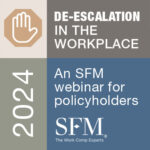If you were to ask employees who the leader of their organization is, most of them would say it’s the CEO, executive director, superintendent or owner.
But if you asked them who the safety leader is, would the answer be the same?
Leadership buy-in regarding safety efforts is critical to maintaining a productive workplace. And it also benefits the bottom line.
Creating an organizational culture where everyone is dedicated to building and maintaining a safe work environment requires commitment to safety from the top down.
A LinkedIn article from late 2023 discusses the importance of involving company leaders at every step of the process, including:
- Safety committees
- Audits, inspections
- Training sessions
Still, it’s everyone’s job to set an example and make safety part of the foundation of your organization.
But if safety isn’t already ingrained in your organization’s culture, how do you get started? Here are four steps toward creating a safety program.
1. Set safety goals
To make your safety program effective, you need to set the right goals for your employees.
Focus on safe behaviors rather than risky ones. Choose goals that relate to safety indicators that are both measurable and specific to your workplace. The best behaviors to observe are those that will prevent injuries from happening. Review your injury records to look for any trends. This will give you a place to start.
For example, if you’re noticing a large number of back injuries due to lifting, you may want to create a safety goal around safe lifting practices. But rather than telling your employees that the goal is to go one month without injuries, instead focus on safe behaviors. Take 15 minutes every day to observe your employees at work and make a note of every time someone uses the proper lifting technique. Set a goal of observing 100 safe lifts in a week.
Not only can these observations encourage safe behaviors, but they can also help correct unsafe behaviors. If an employee doesn’t use proper lifting techniques, it won’t count against achieving the goal, but you can still observe what the employee is doing wrong and make corrections accordingly.
If you center your safety goals around risky behaviors or injuries, then it could cause employees to refrain from reporting workplace incidents. If you set a goal of going incident-free for a month, then if one of your workers is injured on day 28, they might wait to report the injury. No one wants to be the one to break the trend. But waiting to report an injury could lead to both further injury for the employee and decreased production for the company.
By setting positive goals, you can encourage safety without affecting injury reporting.
2. Use positive recognition
Reinforce safety culture with your employees through positive recognition.
When you’re doing your observation, take the time to recognize employees who follow proper protocols. This can be done verbally, or you can consider some sort of reward program.
Put together a safety program based on encouraging good behaviors that relate to the goals you’ve set. Perform regular checks and offer recognition when applicable, while also making note of any areas that need improvement. Have your supervisors do checks at varied times.
3. Get employees involved in safety
Once you demonstrate your commitment to safety, start getting more of your employees involved. Encourage workers at all levels to participate in the program and start talking to each other about safety.
Not only will this increase the number of eyes looking for ways to improve the safety of your workplace, but it will also increase personal awareness of dangerous behaviors and conditions.
Some options include:
- Have your employees do safety observations among themselves
- Ask them to fill out safety checklists
- Start a safety suggestion box
- Perform random knowledge checks
Try a few different tactics to see what’s most effective in getting your employees to start talking about safety.
You can also incentivize participation by offering rewards to employees who get involved in the program. Small prizes, such as $5 or $10 gift cards, are an easy way to encourage employees. You could also consider providing a free lunch or entering employees who participate into a drawing for a larger prize.
Once you get started, it will become second nature for your employees to communicate about safety.
“You know you have an effective safety culture when employees are willing to talk to each other when they’re doing something unsafe,” said SFM Director of Loss Prevention Lee Wendel.
4. Respond to employee concerns
Your employees need to see that you’re serious about creating a safe work environment. Once you have employees talking about safety, you need to make sure to be communicative and follow up on their observations.
If you have employees reporting safety concerns to you that go unanswered, the program will lose momentum, as well as credibility. Not only will this prevent you from improving safety, it could also cause things to swing in the other direction if your workers lose confidence in you.
It’s also the responsibility of senior leadership to make sure all supervisors and leaders who interact regularly with other employees are on board with a safety program. Supervisors need to allow employees time to engage with the safety program.
You’ll also have to ensure your supervisors are supporting any actions taken to correct a safety concern. If a supervisor contradicts a decision, that could bring a quick halt to your program.
Conclusion
Ultimately, when it comes to leadership in safety, your goal is to have all employees view themselves as safety leaders. But you are the person who can make that happen.
“The most common reason a safety program fails is due to a lack of leadership support,” Wendel said. “A senior leader has the power to make a safety program work or destroy it based on what they say and do.”
If you can show your commitment to safety by creating a dedicated program, listening to your employees and encouraging everyone to get involved, the entire company will follow your example.
Originally published in December 2020; updated in August 2024.

